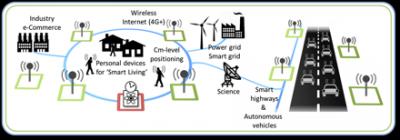SuperGPS: Accurate timing and positioning (SUPERGPS)
Our society relies heavily on Global Navigation Satellite Systems (GNSS) such as GPS for positioning and navigation applications, as well as the distribution of time and frequency reference signals. Despite its proven track record and high economic value, GNSS has a number of serious limitations, in particular in areas where GNSS is needed most, namely in built-up areas (urban canyons) and indoor, where people live, work, and travel. In such areas, GNSS performance is degraded as satellite signals are blocked by buildings and other objects, and GNSS receivers may get "confused" by multiple reflections of GNSS signals.
The accuracy of GPS and other GNSS is also insufficient to distribute a high-precision time reference produced by state-of-the-art optical atomic clocks, due to the inherent presence of atmospheric disturbances. These limitations prevent the development of novel technologies and applications in need of higher accuracies in a cost-effective way. For example, autonomously driving vehicles cannot rely on just GPS for precision navigation due to its limited performance in built-up areas, and therefore need a host of additional sensors. Furthermore, officials have pointed at the risk of "over-reliance" on GNSS, as GNSS signals may at some point be lost due to natural causes (e.g. severe solar storms), or human intervention (signal jamming).
To alleviate these limitations, we propose a novel terrestrial "SuperGPS" system, and the central research question in this project is: How do we realize highly accurate and reliable positioning using extremely accurate time-frequency reference signals, distributed through hybrid optical-wireless networks?
This project will enable a hybrid optical-wireless system for accurate positioning, navigation, and network synchronization, which will complement or even replace satellite navigation technology. This system is accomplished through a terrestrial grid of radio antenna pseudolites, synchronized with extreme accuracy through the fiber-optic telecommunications network.
The key deliverable of the project is a pilot demonstration of SuperGPS technology under real-life circumstances. The project focusses on components which extend the optical telecom data layer with SuperGPS time and frequency reference transfer functionality (with ~10 ps accuracy and 1e10-18 relative stability, respectively), and on a cost-effective enhanced terrestrial positioning system (ETPS) with an accuracy of 10 cm, even under conditions in which current GNSS is not available or strongly reduced in accuracy, such as in densely built-up areas and inside tunnels. This improved performance is enabled by using innovative wideband radio signals, rather than today's relatively narrowband GNSS signals.
Utilisation
Global Navigation Satellite Systems (GNSS) such as GPS provide two services, namely positioning and time distribution. They have enabled groundbreaking technologies with large societal and economic impact over the last two decades. Indeed, today's society has become critically dependent on GNSS-enabled systems and technologies. These include vehicle navigation and systems for logistics and public transport, and vital wide-area networks such as electrical power grids, mobile telecommunication networks (e.g. GSM, UMTS, 4G), and electronic financial transaction and trading systems. However, the accuracy and reliability of GNSS does not fulfill current and future demanding requirements. We propose a radically different approach, for which accurate (optical) time distribution is an essential ingredient.
The results of this project will mitigate the indicated GNSS limitations as they enable transferring GNSS functionality to a terrestrial optical-wireless SuperGPS system, with superior performance, in particular under circumstances which matter. The envisioned SuperGPS technology will improve positioning accuracy from the meter level to the centimeter level, and will add a whole new segment of next-generation positioning and timing products (for e.g. autonomously driving vehicles) to the GNSS navigation market (global size approx. 180 billion in 2013).
The project targets add-on SuperGPS components which fit seamlessly into existing optical telecom infrastructure, and cost-effective wireless transceivers and receivers for positioning. The technology will be developed with support and feedback from potential users in telecommunications (Royal KPN N.V.), mobility (TNO and Volvo), and Dutch high-tech manufacturers, as well as stakeholders from the scientific and R&D community, including the Dutch metrology institute VSL, the Dutch keepers of atomic time UTC, and physicists and astronomers in need of better time and frequency signals. This project also aims to make a significant step towards commercial deployment through collaboration with ongoing Dutch initiatives in the Eindhoven area targeting autonomous driving (TNO Transport & Mobility), and a real-life SuperGPS pilot at the A270 test site.
Outreach
The project resulted in a paper in Nature, with a subsequent article in NRC on 18 Nov 2022. The topic was also covered by IEEE Spectrum.


Project data
| Researchers: | Gerard Janssen, Jeroen Koelemeij (VU), Christian Tiberius (CiTG), Tarik Kazaz |
|---|---|
| Starting date: | March 2015 |
| Closing date: | March 2021 |
| Funding: | 1332 kE; related to group 250 kE |
| Sponsor: | STW, Cor Wit Foundation |
| Partners: | VU Amsterdam, TU Delft CiTG |
| Users: | KPN, VSL, TNO, OPNT, Fugro, Politie, Bruco, Kadaster, JIVE |
| Contact: | Gerard Janssen |